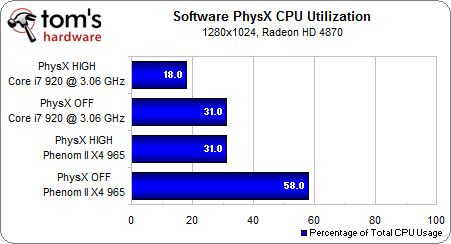Batman: Arkham Asylum: GPUs, CPUs, And PhysX Performance
CPU Benchmarks: PhysX Enabled
We were somewhat puzzled by the results we saw when we benchmarked the Radeon cards at the different PhysX settings. Strangely enough, the minimum and average frame rates stayed static between the Normal and High PhysX settings, even though the GeForce cards showed a large performance hit for the minimum frame rate.
We therefore ran a couple of tests using Radeon cards with PhysX enabled at different CPU speeds:

This would seem to make sense, because the frame rates go down with lower clock rates. Here's the weird part, though. We took note of CPU utilization during a specific part of the game benchmark, a PhysX-heavy segment where a guard is walking through smoke. Results were repeatable and consistent over several runs:

Why is CPU utilization lower when PhysX is enabled? And why is CPU utilization so low at all? If the CPU is bottlenecking the PhysX calculations, shouldn't the increased load be pushing the CPU to its limits?
Maybe we can make more sense of this if we look at how the CPU is handling threads:

Rather than clearing things up, the results of this testing have only left us more puzzled. We can recall that the PhysX API is supposed to be optimized for multiple threads, yet on the Core i7, only a single thread seems to be stressed when PhysX is cranked up. We're trying to get clarification from the developers at Rocksteady about this phenomenon--it's almost as though the game is artificially capping performance at a set level, and is then using only the CPU resources it needs to reach that level. On the Core i7, PhysX is using fewer resources than it does on the Phenom II. This would make sense if there was an artificial performance cap, as the i7 has shown to outperform AMD's architecture. However, the benchmarks show us a correlation between actual performance and raw CPU speed on either CPU.
Stay On the Cutting Edge: Get the Tom's Hardware Newsletter
Get Tom's Hardware's best news and in-depth reviews, straight to your inbox.
Current page: CPU Benchmarks: PhysX Enabled
Prev Page CPU Benchmarks: PhysX Off Next Page Conclusion-
Kohlhagen I just bought an ATI 5000 series card.. can i use my second PCI-E slot with the nvidia 220 to support physX? (i doubt it because AMD/Nvidia GPUs together cause driver issues)Reply -
curnel_D Don--it's almost as though the game is artificially capping performance at a set level, and is then using only the CPU resources it needs to reach that level. On the Core i7, PhysX is using fewer resources than it does on the Phenom II. This would make sense if there was an artificial performance cap, as the i7 has shown to outperform AMD's architecture.With Nvidia pushing proprietary API's like CUDA and PhysX, they're at a point where these things are some of the largest selling points of their products.Reply
With this in mind, and given Nvidia's past Anti-Consumer business practices, I think we can all expect to see a lot more of this kind of thing in the future with TWIMTBP games.
-
2shea @ kohlhagen: with an ati 5000 card you probably won't need that second card if you don't play on the highest resolution.Reply -
nzprogamer im a big fan of amd and im planing to buy the xfx 4850 in the weekend but the gts250 just add another $5-10 i think i will buy the GTS-250. come on ATIReply -
noob2222 Interesting find on the CPU useage with ATI cards. It would appear that Nvidia programmed Physix not to unload programming to the cpu, instead forcing it to the GPU only. Just a speculation since it is thier option.Reply -
sohei this game runs great on any hardware but but , nvidia is just nvidiaReply
why you sell a game to all the people when is just for nvidia cards ?
that.s why i love google.... google sell free things, nvidia is the opposite -
JeanLuc NPD numbers show this game as currently being one of the least popular PC games - 92nd in fact.Reply
Nice article BTW, it's sad that the developers were paid off by Nvidia to drop support of AA on AMD cards (in game menu AA support that, there is a work round for ATI cards) as this shows just how morally bankrupt Nvidia is these days.
And just for the record this isn't a case of AMD not 'supporting developers' as Nvidia would lead you to believe. Never mind the fact it can be enabled via a hack, Richard Hubby from AMD has uploaded an email he got from the developers of Batman Arkham Asylum saying there would be lawsuit if they changed to games code to enable game menu support of AA on ATI cards.